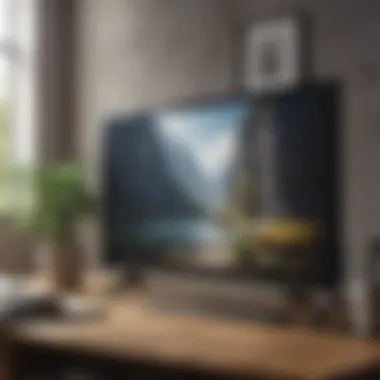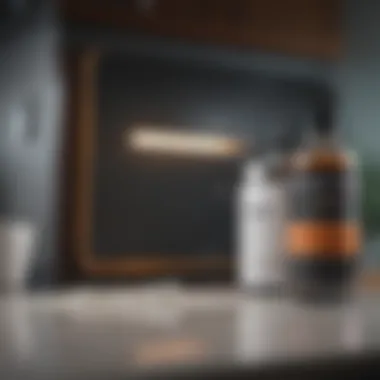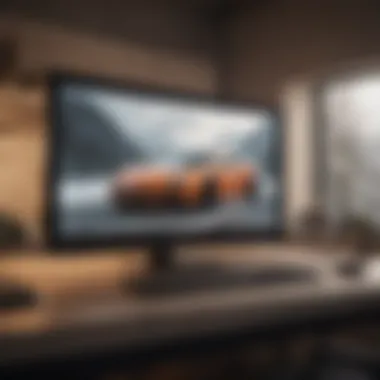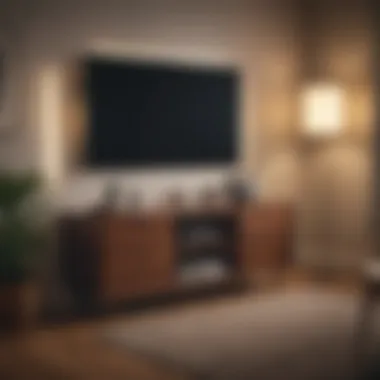Effective Methods to Clean Your Flat Screen: A Comprehensive Guide


Intro
Cleaning flat screen televisions and monitors involves more than just a swipe with any cloth. Many nuances factor in when determining which methods and materials are suitable for cleaning these delicate surfaces. Flat screens can easily become smudged and dusty, which obscures picture clarity and affects viewing experiences. Yet, improper cleaning can also lead to damage, especially if harsh chemicals or abrasive tools are used.
This guide aims to equip you with an informed approach to maintain and clean your TV or monitor effectively. Understanding the right techniques can enhance not only the presentation of your devices but also their lifespan. Well-maintained screens offer optimal performance, making it imperative to integrate regular cleaning into your routine.
In this article, you will discover the materials to use, proper techniques to apply, and handy tips for preventative maintenance. This comprehensive exploration addresses both the do's and don'ts for ensuring your screens remain clear and functional over time. From the selection of microfiber cloths to the suitable cleaning solutions, eventually, you will develop a curated understanding of what your electronic devices need. Miss this critical maintenance and the screen performance may yield diminishing returns, ultimately requesting hefty service fees or replacements.
Maintain the visual appeal of your meticulously selected technology. Let’s dive a little deeper into how to preserve that stunning display you admire so much by following intelligent cleaning methods.
Understanding Flat Screens
Understanding flat screens is crucial before cleaning them. This section discusses the specific types of flat screens and their coatings, which affect how they should be cleaned. Knowing your screen’s make-up can prevent damage during cleaning, ensuring the longevity and optimal performance of your valuable device.
Types of Flat Screens
Flat screen technology has advanced significantly in recent years, leading to several types of screens, each with distinct characteristics. Primarily, there are three main types of flat screens users encounter:
- LCD (Liquid Crystal Display): LCD screens are common in many devices and are known for their clear image quality and lower power consumption.
- LED (Light Emitting Diode): Actually, a type of LCD, LED screens use diodes for backlighting. They are brighter, consume less energy, and are more color accurate than traditional LCDs.
- OLED (Organic Light Emitting Diodes): Unlike LCDs, OLED screens emit their own light and offer deeper blacks and vivid colors. They tend to be more delicate, requiring careful handling during cleaning.
Recognizing the type of flat screen you own is vital when selecting cleaning supplies and methods. Each has a different sensitivity to cleaning solutions which can alter its surface or even void warranties.
Common Screen Coatings
Flat screens often come with various coatings designed for display clarity or anti-glare. Recognizing these coatings helps tailor cleaning approaches. Common coatings found on flat screens include:
- Anti-Glare Coating: Reduces reflections but can be prone to scratches.
- Glossy Coating: Provides vibrant colors and black levels but needs more frequent cleaning due to visible fingerprints.
- Protective Coating: Some screens have additional layers to guard against scratches, helping them withstand delicate cleaning processes.
Understanding these coatings is essential. Using rough materials or inappropriate cleaning solutions on screens with special coatings can cause irreversible damage. Therefore, identifying the coating on your screen is as important as knowing the screen type before proceeding with any cleaning method.
Importance of Proper Cleaning
Cleaning flat screens is not just about aesthetics. Maintaining cleanliness has significant implications that affect both performance and longevity. Many may underestimate how fine dust or fingerprints can lead to larger problems over time. Watching your favorite movie or show on a dirty screen can quickly diminish the visual experience. Thus, proper cleaning becomes an essential practice almost like a ritual for preserving the clarity and functionality of these devices.
Impact on Picture Quality
Dirty screens can distort the quality of the images they display. Fingerprints, dust, and smudges can create blurriness, significantly impacting contrast and color accuracy. Bright scenes can look dimmed due to accumulated grime, making vibrant colors appear dull.
The clarity of the display is fundamental for a pleasant viewing experience. When the screen is clean, it can showcase true colors and sharp details. This enhances everything – from watching cinematic landscapes in films to reading small text on a webpage. Not realizing these impacts could lead one to think a device is underperforming when, in fact, a simple cleaning would resolve the issue.
Key Consideration: The routine cleaning of screens contributes immensely to their visual output and should never be neglected.
Prolonging Device Lifespan
Neglecting screen cleaning has more serious consequences than just poor picture quality. Dirt and dust buildup can work their way into crucial electrical components and side vents. Over time, this could cause overheating, short-circutting, or even bricking the device, leading to costly repairs or replacements. By keeping screens clean, owners can significantly reduce these risks.
Moreover, most manufacturers recommend regular maintenance as a key factor in sustaining their warranty. If a screen is not cleaned regularly, dust may cause a host of issues that manufacturer warranties won't cover. Hence, maintaining cleanliness also ensures device functionality aligns well with manufacturer expectations.


Preventive cleaning measures not only safeguard investment but also enhance overall operation, ensuring that your technology fulfills its potential for years to come. Regular cleaning can go a long way in preventing avoidable malfunctions.
To conclude, proper screen cleaning is not a simple chore; rather it is an integral process that significantly affects picture quality and device longevity.
Recommended Cleaning Supplies
When it comes to cleaning flat screens, the right supplies matter significantly. Having the correct tools and materials on hand not only facilitates an effective cleaning process but also prevents harm to delicate surfaces. A poorly chosen cleaner can leave streaks, damage coatings, or even lead to more significant issues over time. Therefore, understanding the categorization of cleaning supplies is fundamental for maintaining the display's appearance and functionality.
Specialized Flat Screen Cleaners
Specialized flat screen cleaners are formulated to effectively clean a variety of flat-screen devices, such as televisions and computer monitors, without causing damage. These cleaners are specifically designed to cut through smudges and fingerprints while being gentle enough not to harm the screen’s surface.
It's recommended to look for non-abrasive, alcohol-free options that help prevent any stripping of protective coatings found on many screens. Brands like ZeroScratches and ScreenMom offer notable products that have received positive recommendations within user communities.
Using specialized cleaners comes with additional benefits, such as their time-saving aspects. Their easy application means that users will find themselves using less effort, achieving clearer screens more quickly. Always ensure to follow the product instructions accurately for the best results.
Microfiber Cloths
Microfiber cloths are another essential cleaning supply for flat screens. This type of cloth features a dense weave that traps dust and particles while absorbing moisture. Unlike paper towels or traditional rags, microfiber is soft and non-abrasive, which significantly reduces risk of scratching screens.
It's advisable to use dry microfiber cloths first to lift dust without introducing any liquid. In cases where streaks remain, lightly dampening a cloth with an appropriate cleaning solution is a wise course of action. Opt for high-quality brands like E-Cloth or MagicFiber to ensure durability and effectiveness. Purchasing multiple cloths ensures you always have a clean one ready.
DIY Cleaning Solutions
DIY cleaning solutions can penetrate the effectiveness of commercial products while offering economic benefits. Simple mixtures, such as distilled water combined with a ratio of 50/50 vinegar or vinegar diluted with water, can yield decent results.
When crafting DIY solutions, always ensure that any ingredients used are safe for electronics. Products containing ammonia or alcohol should generally be avoided, as they can damage coatings or create film residue.
Making your own cleaning solution allows greater control over what is applied to your screens. Ensure airtight storage for any unused portion to preserve its efficacy.”
— “Research user recommendations when considering commercial cleaners for assurance against damage.”
Step-by-Step Cleaning Process
Cleaning a flat screen necessitates an organized approach to prevent damage while also ensuring effectiveness. When you methodically clean your screen, you avoid introducing any factors that could lead to scratches or smudges. \n From gathering your tools to understanding specific techniques for different surfaces, this section aims to empower you with a thorough cleaning process. Emphasizing each component provides clarity and ensures that you attain a pristine screen. \n Recognizing these nuances protects your investment and enhances your viewing experience, holding particular importance for those who appreciate quality in their daily entertainment or work.
Preparation and Safety Measures
Before starting, preparing your environment is crucial. Make sure you turn off and unplug your flat screen. This step increases your safety and allows you to see smudges better when the screen is dark. Additionally, let your device cool down if it has been in use. Avoid cleaning while the screen is warm as this can cause damage. Good practice is to wear lint-free gloves; this choice minimizes the risk of fingerprints. Also, evaluate the space you are cleaning. Ensure no loose items are present that might fall and damage your device or disrupt your cleaning motions. It can also help to read the manufacturer's instructions regarding cleaning. This specific understanding is often overlooked but can save you from unnecessary issues.
Applying Cleaning Solutions
The second critical phase involves the appropriate application of cleaning solutions. Only use cleaners designed explicitly for electronic screens. Products such as Screen Mom and iKlear are reputable options. You can utilize a spray bottle or a damp cloth, but avoid directly spraying liquid on the screen to prevent spills from seeping into electronics. For a DIY solution, a mixture of distilled water and white vinegar, in equal parts, is acceptable. It offers a gentle alternative that can also be (as cleaning bouquets say) eco-friendly. Spray your cloth lightly instead of soaking it; the general rule is 'less is more.' This steady approach avoids excessive moisture on the screen, which can cause harm over time.
Wiping Techniques
In this stage, the actual cleaning occurs, and technique merges with strategy. Use circular motions or linear strokes, dependent on personal comfort, but never apply pressure than necessary. Always wipe from the center to the edges; this progression minimizes streaks. Incorporating microfiber cloths allows for effective dust removal without scratching the surface. While cleaning, be careful around buttons or crevices, as these spots may trap debris significantly. If faced with persistent spots, let the cleaning solution sit for a few seconds before wiping to allow it time to break down dirt.
Finishing Touches


The concluding part of your cleaning process reinforces all previous efforts. Start with inspecting the screen for any remaining smudges or missed dust. If the screen is streaky after your initial clean, damp a fresh section of your cloth with just water and gently buff those areas. Make sure to ensure that no moisture is left lingering in any edges or crevices. Take a moment to admire the achieved result. With satisfcation comes a chance to plug back in your device, hence often consider the cables' neatness. Lastly keep your cleaning tools organized for future routine cleaning, thus offering convenience next time.
Always remember, consistent cleaning helps in retaining the enchanting image quality the flat screen provides!
Cleaning Mistakes to Avoid
Cleaning flat screens is a task that many individuals tend to approach casually, oftentimes leading to detrimental mistakes. It is vital to understand the common pitfalls during cleaning to maintain the integrity and performance of these devices. Small oversights can lead to scratches, streaks, or even permanent damage, which might also decrease the display quality. Avoiding these mistakes not only helps in achieving a clean screen but also prolongs its lifespan, which can be quite beneficial for your investment. Let’s delve into the specific errors to steer clear of during your cleaning routines.
Using the Wrong Materials
Many people make the error of using inappropriate materials for cleaning their flat screens. Common household items like paper towels, rough cloths, or abrasive cleaners can leave scratches or smudges. Eyeliner pens and every kind of liquid you might find, like alcohol-based products, can further damage special coatings that are on modern screens.
Instead, opt for the right materials:
- Microfiber Cloths: These are designed to gently lift dust and smudges without harming the screen’s surface.
- Specialized Cleaners: Use cleaners formulated for flat screens. Avoid harsh chemicals and abrasive substances that might scrape the screen.
Investing in proper cleaning aids can greatly reduce the risk of screen damage and can enhance your cleaning effort.
Excessive Pressure While Cleaning
Applying too much pressure when cleaning can be damaging. The screens are thin and might not handle the strain from aggressive cleaning. Excess force can lead to pixel damage or even cracks.
Here are few tips to prevent this mistake:
- Gentle Wiping: Always remember to wipe gently, letting the cloth do the work. Just a light touch is all that is needed to remove dirt.
- Circular Motion: Use a circular pattern when wiping. This will help to distribute any pressure without causing localized damage.
It’s critical to train oneself to be mindful of the pressure applied during cleaning to ensure the screen stays intact.
Neglecting Screen Edges and Bezels
Many individuals focus mainly on the central part of the screen but ignore screen edges and bezels. These areas can gather significant dust and grime. Undercleaned spots not only produce an unkempt visual but can also interfere with how devices fit into their mounts.
To tackle this oversight:
- ** thorough Inspection**: After cleaning the screen, take a moment for an inspection of edges and bezels and clean those areas specifically.
- Use Cotton Swabs: For corners or hard-to-reach areas, use a cotton swab lightly dampened to clear out residue without oversaturating the area.
Adopting these practices can ensure that your flat screen looks its highest quality from top to bottom.
Remember, a well-maintained screen not only performs better but also enhances the enjoyment of the viewing experience. Monitor and take care of those often-overlooked sections for a complete clean.
Preventative Maintenance for Flat Screens
Flat screens comprise a significant investment in many homes and businesses. Therefore, preventative maintenance serves as a fundamental approach to ensure their longevity and performance. Regular care not only maintains picture quality but also minimizes the risk of incurring heavy repair costs that might arise from neglecting screen cleanliness.
Regular Dusting
Dust accumulates quickly on flat screens, which can cause image distortion and overheating. Designated areas of your living or work space might attract more dust due to open windows or nearby activities. It is neccesary to establish a routine that includes gentle dusting of your screen. Use a microfiber cloth because it traps dust effectively without scratching the surface. Wipe the screen lighttly, making sure to avoid applying much pressure, to evade damaging the display. Regular dusting not only improves display clarity, it concurrently reduces allergens floating in your environment.
Maintaining consistent cleaning practices can significantly impact the visual experience. Consider dusting, at least, once a week, especially in environments where the screens are frequently used. This simple act of care plays a vital role in enhancing both the appearance of your flat screen and associated health benefits.


Optimal Placement for Reduced Dust Accumulation
Placement of your flat screen is equally important as the cleaning methods employed. Avoid corners of rooms or poorly ventilated spaces. These areas tend to harbor more dust and grime. High elevation surfaces can also contribute, as dust particles tend to settle on top of screens. Ensure proper distance from electronic devices that produce static, such as speakers or poorly shielded equipment, as they can attract more dust.
Positioning your screen perpendicularly to airflow can assist in dust avoidance as well. If possible, use materials that reduce static electricity around your flat screen. Choosing to unclutter areas around the screen not only makes cleaning simpler but is beneficial in avoiding dust build-up as well. Ultimately, strategic placement of your flat screen enhances its lifespan complementing the efforts made during the cleaning process.
Keeping screens clean and dust-free shouldn’t be an afterthought, stratergically placing them ensures a clearer display, making preventative maintenance immensely effective in avoiding possible problems down-the-line.
Assessing your habits towards cleaning flat screens and optimizing their placement can yield dividends in functionality and longevity.
When to Seek Professional Help
Choosing to clean a flat screen has its own set of challenges. However, there are circumstances where professional assistance becomes necessary, due to the intricacies involved in certain devices and potential damages that could occur. Understanding when to seek out an expert in screen cleaning is essential. One major reason is that specific issues can worsen if not handled correctly. Moreover, seeking help from professionals ensures that your device retains its warranty and functions effectively after the cleaning process.
Identifying Significant Damage
When dealing with a flat screen, visual and functional assessments are crucial in determining if significant damage exists. If you notice lines across the display, image distortion, or color discrepancies, these could indicate underlying problems that ordinary cleaning cannot rectify. Additionally, consider how the screen's surface feels. Any unusual texture change may signal possible harm which requires skilled examination. Engaging a professional might uncover issues that are not immediately visible but could escalate if left unattended.
For complex damage situations, the intervention of a qualified technician can save time and reduce the risk of further damage.
Key Signs to Watch For:
- Adverse visual effects: Horizontal or vertical lines interrupting the display.
- Unusual sounds: Cracks or pops that do not align with routine operation could posit changes in hardware.
- Unresponsive areas: Areas that no longer react to inputs might need complete repair or replacement.
Understanding Warranty Limitations
Owning a flat screen usually comes with a warranty that covers a wide gamut of issues. However, improper cleaning practices can potentially void these warranties. Typically, warranties are protective measures that ensure customers receive restitution for factory defects or serious malfunctions. By conducting cleaning independently, especially if employing incorrect methods, owners risk losing these advantages.
Before cleaning, it’s advisable to review the specific warranty terms of your device. Verify whether direct cleaning impacts your warranty claims. A clear understanding helps in making informed decisions about employing self-cleaning habits opposed to professional maintenance. Taking heed of these limitations preserves your rights as a customer, along with improving the longevity and functionality of your flat screen.
Considerations of Warranty:
- Review warranty details sharply focusing on maintenance clauses.
- Seek professional advice if unsure about cleaning pmethods that are safe for your screen type.
- Document any professional cleanings, providing a trail in case claims become necessary later.
Ultimately, knowing when to seek professional help allows for the effective maintenance of your flat screen while safeguarding its performance and warranty.
Finale
In this article, we addressed multiple facets of effective flat screen cleaning. The significance of proper techniques cannot be overstated. Clean screens not only enhance your viewing experience, but they also safeguard your investment. Dust, smudges and other residues can compromise picture clarity. Thus, a diligent cleaning routine is essential to maintain visual quality. Moreover, neglecting this crucial aspect can shorten the lifespan of your device.
Recap of Best Practices
When it comes to keeping your flat screen clean, sticking to best practices is vital. Here’s a summary of the essentials:
- Use appropriate cleaners: Invest in specialized flat screen cleaners that are safe for coatings.
- Utilize microfiber cloths: These materials are gentle and resistant to scratches.
- Gentle wiping techniques: Always wipe in circular motions and avoid excessive pressure.
- Regular check-ups: Ensure to monitor for damage or buildup sometimes overlooked.
Following these simple steps can result in a cleaner screen and ultimately a better viewing experience.
Encouraging Regular Care
Maintenance is not a one-time action. Establishing a routine is beneficial. Set a schedule for cleaning, at least once every few weeks. This will prevent the build-up of dust and grime, making each cleaning easier overall.
It is also advisable to adjust the placement of screens. Minimize dust accumulation by choosing optimal surroundings. Screen care may seem minor, but it has long-term impacts. Therefore, commit to regular monitor upkeep to enjoy sustained picture clarity and device performance.
By engaging in preventative practices, you contribute significantly to the performance and longevity of your technology. Regular attention pays off well into the future.



